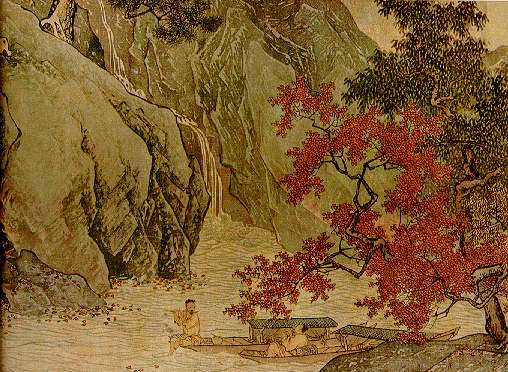|
The origins of traditional
Chinese painting reach far back into China's
distant history. Generally speaking, works
dating from before the T'ang dynasty (618-907
A.D.) are mainly line drawings of people engaged
in various activities; this was the "golden age"
of human figure drawing. By the mid-T'ang
dynasty, landscape and flower-and-bird paintings
began their rise to prominence. Paintings of
mountains, forests, fields, and gardens have the
ability to transport one away from the vexations
of the material world into a peaceful, carefree
realm. Because of this, landscape paintings have
always been highly regarded by China's literati
and officialdom. The flowers, grass. trees.
stones, and birds and other animals depicted in
the lively and energetic flower-and-bird
paintings are also widely admired. Thus the
landscape and flower-and-bird types of painting,
together with the earlier human figure painting,
comprise the three main categories of
traditional Chinese painting.
 The ruling and elite classes of
the T'ang and Sung (960-1279 A.D.) dynasties
were major supporters of Chinese painting. The
creative aim behind artistic works produced in
this period was more serious, and had political
and educational significance; in style, the
works tended to be elaborate and ornate. The
Sung dynasty court established a fairly well
systematized academy of painting. Sung Emperor
Hui Tsung, a lover of fine art and painting, and
an accomplished artist in his own right, granted
special patronage to the painters in this
academy, and sponsored the training of promising
painters. The academy of painting reached the
zenith of its activity in this period.
However, because of gradual,
social, economic, and cultural changes, more and
more men of letters began to take up painting,
and literature came to exercise an
ever-increasing influence on painting. By the
time of the famous Sung poet Su Shih, the school
of literati painting had already emerged. By the
Mongol Yuan dynasty (1271-1368 A.D.), there was
no longer a formal painting academy organization
within the imperial palace, so the court style
of painting declined. At this point, the
literati school of painting entered the
mainstream, and the leadership in Chinese
painting circles fell into the hands of literati
painters.
Literati typically prefer to
paint according to their own fancy and without
restriction, and advocate a fresh, free,
understated, and elegant style. Subject matter
they are fond of includes mountains and rocks,
clouds and water, flowers and trees, the "four
gentlemen" (plum blossoms, orchids, bamboo, and
chrysanthemums), and so forth. Because natural
objects such as these are less demanding
subjects to paint than the human figure, the
painter can better exploit the brush and ink's
potential for free expression.
Whether Chinese painting is
"realistic" is the object of frequent debate.
Some may feel that it is not realistic, but such
an answer tells only part of the story. Realism
in Chinese painting reached its climax in the
painting of the T'ang and Sung dynasties.
However, the kind of "realism" sought after in
Chinese painting is not an objective reflection
of the existence of an object as perceived
through the sense of sight, but rather is an
expression of a subjective kind of recognition
or insight.
Go to Page 2
|


